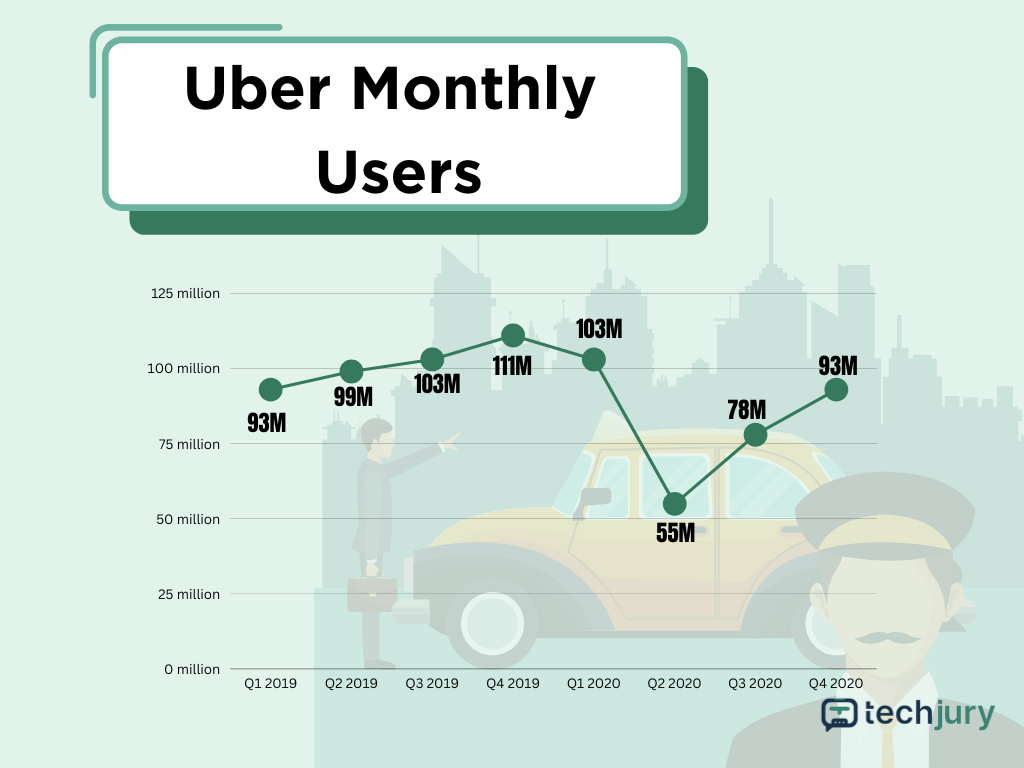

Updated · Feb 11, 2024
Updated · Jan 02, 2024
Deyan is an avid enthusiast and self-proclaimed fan of the Windows operating system. His passion for... | See full bio
If I was asked to describe myself using just a few words, I’d go with digital marketing expert, ex... | See full bio
The Uber vision of its founder, Travis Kalanick and Garrett Camp, has grown and exceeded the borders of San Francisco, where it was launched in 2010. Then, the company went public in 2019.
In no time after its initial public offering, Uber dominated the ride-sharing market with 71% of shares.
As the company goes global, you must know about the statistics surrounding its growth, market size, usage, and demographic.
|
There are more than 5.195 million apps available, and Uber is known by many as an app that can simplify travel arrangements.
In 2011, Uber's value was $60 million, but if you want to know how much the company is worth today, read more.
(BBC, NY Times, Macro Trends)
Uber’s initial public offering had an impact on the company’s valuation. The company was valued at $120 billion in 2018 and saw a decline to $90 billion by May 2019 after the IPO.
The company’s value decreased by a slight $2.92 billion margin in 2023. However, considering the widespread economic recession in the US after the pandemic, Uber is doing well and still has a bright future ahead.
(Backlinko)
Uber takes a small service fee for every ride booked through its platform. This service fee goes towards its mobility revenue.
In 2020, Uber gathered a mobility revenue of $6.1 billion, a significant plummet from the previous year’s worth of $10.7 billion.
How did such a huge company lose so much revenue? Uber was set out for a continuous spike, but like most businesses, it was not safe from the effects of the COVID-19 pandemic. During that, people stayed home more, and fewer Uber rides were needed.

(Pew Research)
Almost every US citizen has heard of ride-hail (99%), which refers to a customized ride that a customer books online via a smartphone application.
Ride-hailing has grown in popularity because it provides a quick and easy form of transportation that is frequently less expensive than traditional vehicle services.
Because of that, over a third (36%) of Americans use such a service, mainly with Uber and sometimes its competitor, Lyft.
(Second Measure)
Uber was founded in 2009 and became the first ride-hailing service ever. With that, it’s unsurprising that Uber leads the ride-hailing market in the US, owning 74% of it.
Meanwhile, Uber’s main competitor, Lyft, holds the rest of the market share at 26%.

Inevitably, customers and drivers in the US choose between Uber and Lyft. However, one thing is for certain: Uber is among the ride-sharing app giants in the industry.
(Yahoo Finance, Medium)
While most ride-sharing service consumers may use more than 1 hailing platform, many turn to Uber.
With 3.9 million drivers across the globe, Uber’s 75 million riders stay accommodated and seated.
|
💡 Did You Know? Driving for Uber is a popular part-time gig that supplements the income of millions of freelance drivers worldwide. |
(Uber, Backlinko)
As of February 2023, Uber trips are available in over 10,000 cities. While that figure shows Uber has moderate coverage worldwide, the US represents almost half its market and profits. Around 52% of Uber's revenue comes from outside the country.
Still, Uber will surely expand to more places, as most companies do, while incorporating better features and services.
(Business of Apps)
The 2022 data on trips completed by Uber drivers show that the service is recovering from the plummet brought by the COVID-19 pandemic.
In 2021, drivers only completed 6.36 billion trips. It increased by 20.6% the following year, leading to 7.64 billion trips.

The shared rides business raised many questions in the last few years due to the following issues:
Although Uber found some ways to resolve or reduce the occurrences of these setbacks, the market continues to experience a push and pull.
The statistics surrounding its market size and reach shall reflect the future of ride-hailing services.
(Statista)
The need for convenient transportation is universal. Although Uber is the first-ever ride-sharing service, it does not monopolize services alike worldwide.
China holds the largest share worldwide in this growing industry, with a market worth over $64 billion as of January 2020.
The largest ride-hailing companies are owned and based in various cities worldwide. They are:
(aPurple)
That figure is much higher than the penetration rate of ride-hailing app users worldwide in 2020, at 8.1%.
Revenue for ride-hailing services is also expected to exceed $133 billion by 2023, with an annual growth rate of 12.8%.
Increased in the market is bound to bring in more options for users and riders, giving way to a higher penetration rate.
Shared rides are taking more and more of the urban travel market. The taxi industry still needs to develop an adequate response, but it remains relevant today.
Here’s what people think of Ubers or ride-hailing in general, vs. taxis:
|
What people who prefer Uber says about it: Comment
Meanwhile, some people prefer taxis better: Comment
|
Apart from what people say about ride-hailing vs. taxis. The statistics also reflect a split between the two.
See the latest dynamics between ride-hailing services and taxi cabs through the data below.
(Back Linko)
Following the above mentioned other pro-ride-hailing states in the US are:
On the other hand, Uber has the lowest market shares and weakest presence in Phoenix and Detroit, with only 56% market dominance.
Even so, US states where Uber had the lowest market shares still exceeded the 50%, meaning they still outnumbered taxi cabs in the area by a slight margin.
(Back Linko)
For those who are curious about the success of Uber in the US, statistics showed that about 63% of ride-hailing customers in the country use Uber exclusively.
These consumers were satisfied with Uber's service. According to a recent report, 54% of them would switch to a competitor if they felt their wants weren't being met—the primary reason most customers remain loyal.

The numbers confirmed that Uber dominates the country’s ride-hailing market despite only having a 2-year headstart from the competing company.
When Uber was founded in 2009, it started with only 150 employees—a number that has grown significantly since then.
That’s not the only figure to consider when reflecting on Uber’s success. Check out the statistics on Uber’s workforce, popularity, and usage in the details below.
(Wikipedia, NY Times)
The company’s workforce was spread out worldwide as it offered services globally.

As modern offices emphasize workplace diversity, the door of Uber’s offices is open to everyone.
(Back Linko)
In 2020, 247 billion apps were downloaded worldwide, a 29 billion difference from 2018’s statistics of 218 billion app downloads.
Uber’s app was downloaded 95 million times on Android and iOS devices that same year. In contrast, its competitor Lyft was installed only 25 million times in the same year.
Such high numbers for Uber signify that more people continuously show interest in Uber’s services, making it a household name in the ride-hailing industry.
(Back Linko, Statista)

Uber’s monthly user count took a hit when the pandemic started and dropped from 111 million monthly active users in Q4 of 2019 to 55 million in Q2 of 2020.
Luckily, the numbers have been growing again. In the first quarter of 2023, Uber’s users rose to 130 million.
With things returning to normal after the pandemic limitations were lifted, the number is bound to rise continuously.
(Wallet Investor, Gov Capital)
Uber’s stock price was $51.73 in May 2021, which decreased to $43.80 by June 2023.
While the recent decrease in Uber’s stock price may discourage investors, the stock market is known for its volatility, which means things could change anytime.
Financial experts predict a future value of at least $169 by 2026, making Uber a promising investment route.
(Politico)
With 3.5 million drivers on the platform, Uber is meant to spend that much on them. On the other hand, the drivers also received $1.2 billion in tips since 2015.
However, such a high cumulative salary doesn’t mean drivers live comfortably. Uber drivers often work 70+ hours per week to earn an income they're comfortable with.
|
Here’s a discussion that puts the salaries of Uber drivers into perspective: Comment
Proving it’s a different experience for all Uber drivers and the salary depends on the driver’s effort and strategy, here’s another perspective to note: Comment
|
Despite Uber’s efforts to pay its riders a fair amount for the service they do, many of them still have to rely on tips and extras to make enough.
(Start IO)
What are Americans’ favorite things about Uber? Convenience.
Times are changing in the US, and the tides are undoubtedly turning in favor of Uber. The most common reason people use Uber is to go to or come back from a dinner or a party.
With Uber, going home after a night out is more manageable than forcing someone to be the night’s designated driver.
|
What makes people rely further on Uber is that the company understood its assignment as this era’s designated driver.
|
(Back Linko)
In August 2020, Uber launched its monthly pass subscription service. This service provides members exclusive deals, such as:
Subscription services like that of Uber are a big hit among users who regularly use the platform and seek more discounts and deals.
The service is fully operational in 16 countries worldwide, with plans to expand.
Uber has cemented its position as the earliest player in the ride-hailing industry. Experts also agree that Uber provides a unique service.
Check out the statistics below to see what titles and records Uber has won over.
(CNBC)
CNBC's "Disruptor 50" lists startup companies whose innovations change the world. With that in mind, being second is plain awesome.
You wonder who is on the top of the list—Unsurprisingly, it's SpaceX.
Uber’s rank confirms that its entrance to the ride-hailing market opened doors for many other start-ups with a similar focus.
As of June 2019, Uber's revenue has other sources than transporting people.
Check out the statistics below to discover how Uber has been transforming the industry outside of ride-hailing.
According to Gallup, 84% of US adults order food at least once a month, and Uber took advantage of that market.
See how Uber Eats has grown in the last few years through the statistics below.
(Similar Web)
Like Walter E. Disney once said: "Whatever you do, do it well."
Uber is in it to win it. The company began its food delivery venture in 2014, launching Uber Eats as a subsidiary.
It’s a food delivery service where customers order food online, and couriers use a car, scooter, or bike. Sometimes, some couriers even deliver food on foot.
The food delivery app penetrated 1% of the global market with $7.9 billion of Uber Eats Gross Bookings.
The company believes Uber Eats is the largest food delivery platform outside of China. That's impressive progress in just 3 years.
(Business Of Apps)
The food-delivery platform has contracts with more than 600,000 restaurants worldwide.
It shows that Uber isn’t just a trusted company for ride-hailing services. Restaurant owners also trust Uber to handle their food and impress their customers.
|
Here is some Uber Eats moments the people of the Internet love: Y’all ever catch any funny moments while doing deliveries?
|
The company doesn't transport only people and food. They are into goods transportation as well. Check out the statistic below to see how Uber Freights' market debut went.
(CNBC)
Uber launched its logistic arm, Uber Freight, in May 2017, and it became a significant force in shipments.
The company has contracts with over 36,000 carriers and more than 400,000 drivers. In Q3 of 2020, this part of the company made $290 million, a 30% improvement from the same period in 2019.
Uber's financials will go through the roof if this trend continues. Success in the freight logistics industry is just one of the company’s many successful ventures outside ride-hailing.
No matter how you choose to travel, traffic is always a pain in the neck. As always, Uber tries to help their commuting customers while also impressing them. With that, Uber started Uber Elevate, an aerial ride-sharing service.
Here are some Uber Elevate statistics to take you off if you've ever thought about ignoring the traffic and flying over it.
(The Guardian)
Uber has taken the phrase “the future is now” to a new level with the Nexus aircraft exhibited in the 2019 Consumer Electronics Show.
Bell Helicopter, Uber’s partner company, launched the aircraft in Las Vegas, hoping to establish the first aerial ride-sharing network soon.
As of 2023, news of the Nexus has yet to come out. However, this feature won't be far off considering the recent launch of Uber flights and other next-level ride-sharing networks.
(Uber Newsroom)
Uber released plans to incorporate long-distance travel using flights, buses, boats, and trains in 2022.
Those plans became a reality for Uber users in the United Kingdom last May 2023. Uber started offering long-distance transportation options for riders who wanted a one-stop shop for their logistical needs.
Before then, users had to book flights, bus, boat, and train tickets through individual websites—a process now made easy by the company.
UK riders can now enter their domestic or international destinations, and logistical options of all kinds will be offered.
The rest of the world is watching as this new venture enters the UK and out to Europe. Any successes made in this market will help the feature expand worldwide.
(Fortune)
As presented in previous statistics, Uber has been interested in vertical take-off and landing (VTOL) aircraft.
This was further confirmed when the company partnered with the following VTOL companies:
From the looks of it, Uber riders will see at least 5 different models of aerial taxis soon.
If the presented Nexus is anything to go by, it’s bound to be impressive.
It may not be a direct answer, but Uber’s Co-Founder and Former CEO Travis Kalanick said, "When I'm having a bad day, I just go to our overall revenue graph."
Be the judge, and see Uber’s financial statistics through the details below.
(Ridester)
According to Uber Estimates, the average trip distance is 16.16 miles. Then, the average Uber rates worldwide are about $1 to $2 per mile. Doing the simple math, the figures reflect the average Uber ride cost of $25.37.
Suppose you want to ride in a luxurious vehicle with a professional driver (UberLux). In that case, you'll have to spend a bit more.
(CNN)
Another exciting thing about Uber is that they are developing a fleet of autonomous vehicles. The company is already involved with Volvo and Daimler.
Toyota is now the latest addition to Uber’s fleet.
Uber Advanced Technologies Group (ATG) is responsible for Toyota's Sienna minivans transformation into an autonomous vehicle. The retrofitted models were beta-tested in 2021.
ATG is also working on autonomous trucks for Uber Freights.
It doesn’t surprise that investors are flocking over to Uber after their recent ventures. They’ve proven time and time again that they’re able to penetrate markets of all types with their strategies and services.
(Business Of Apps)
Although Uber's financials look good initially, the company still loses money yearly.
Uber's stats show that its revenue in 2020 was 15.6% less than its 2019 revenue of $13.19 billion.
However, previous ventures taking off and showing ROI give Uber a bright future. There’s every chance of the company’s overall revenue bouncing back for the coming years.
(CNBC, BBC)
The company hasn't been much profitable for the last couple of years.
In 2019, Uber reported $8.51 billion in losses. The biggest of Uber's competitors in the US, Lyft, is in the same boat.
According to BBC, the company’s previous losses were mainly due to the decreased investment value of their Asian partner companies like Grab and Didi.
(Lyft, Bloomberg)
As bad as that sounds, 2020 was a pretty good fiscal year for Lyft compared to 2019, where the company recorded a net loss of $2.6 billion.
Lyft and Uber share a lot of similarities. Both companies rent e-bikes and e-scooters, and their ridesharing platforms deliver excellent results.
As reported by Bloomberg, Lyft’s losses were due to intense market competition and recent regulation changes that forced them to set aside money for insurance reserves before operating.
Uber and Lyft have the same goal; they want you to use their apps anytime you want to travel.
Check out their most recent market, operational, and popularity statistics as they go neck and neck in the logistical market.
(Statista)
While Uber carried the largest share of the ride-hailing market, Lyft came in second as its biggest competitor.
Both companies push and pull in terms of market advantages, particularly in area coverage, cost, driver availability, and luxury vehicle types.
(The Rideshare Guy)
In the survey, 58.7% of the drivers said they worked for Uber alone. Drivers, exclusive to Lyft, represented 16.8% of the interviewees.
Being able to drive for different platforms and other personal reasons makes being a ride-hailing driver an ideal occupation for some people.
|
But which is a better choice when it comes to working as a driver? Here’s what people have to say. Let’s look at this driver who chose to exclusively use Uber: Lyft v Uber: a verdict
Meanwhile, this driver picks Lyft over Uber: 6 years Uber vs Lyft
|
(Earnest)
According to Earnest's data, almost half (45%) of Uber drivers earn less than $100 monthly. Meanwhile, most Lyft drivers (48%) make between $100 and $499.
Only 1% of Lyft's drivers make a living out of ridesharing with earnings over $2,000. According to Earnest, all Uber drivers need to reach that amount.

Remember that ridesharing drivers are responsible for all vehicle-related expenses like gas and vehicle maintenance.
Earnings for these ride-hailing drivers may take more work, but both companies strive to provide the best platform to earn a living.
(Statista)
Lyft operates only in the US and Canada, which explains its lower revenue than Uber.
According to ride-hailing stats, Lyft had 12.5 million active riders in 2020.
The silver lining to this would be Lyft’s opportunity to expand to worldwide markets and possibly earn more.
(Statista)
Lyft and Uber's statistics agree on one thing—22.1% of their US drivers drive a Toyota.
Although Toyota isn't the top vehicle manufacturer in the US, the company owned the lion's share of the global automotive market last year at 9.46%.
There are 2 groups to consider when discussing Uber’s success: their riders and drivers.
In this section, you’ll see several statistics and facts about Uber drivers, including their demographic make-up and the reason behind their occupation.
(Ridester)
There is almost a perfect split between Uber drivers who do this job alone for a living and those who work somewhere else.
For Uber drivers, about 74.7% of them operate under UberX, while only 0.5% provide the UberLux service.
Considering the low earnings most drivers could get with driving, it is no surprise that most Uber drivers have another source of income to make ends meet.
(The Rideshare Guy)
Flexibility is among the crucial factors in getting someone to become an Uber driver. More than one-third (35%) say the ability to work whenever you want is why they became Uber drivers.
|
🎉 Fun Fact: A study reveals work flexibility increases employee satisfaction by 65%. |
The main reason for drivers, however, is money. More than half (55.2%) work for Uber because of the (extra) income.
(Ridester, Forbes)
Uber stats show that only 11% of drivers have worked for the company for 3 or more years. Around half of the drivers (46.4%) started in less than 12 months.
Forbes reports that the high turnover rate for Uber drivers is due to low earnings. Many drivers are quitting in favor of higher-paying jobs.
(Economic Policy Institute)
The on-demand economy of ride-hailing is far different from the typical 9-to-5 job. Drivers only get paid when they have customers—simple as that.
According to EPI's research, the typical Uber driver works 17 hours a week and earns an average of $9.21 in hourly wages after expenses like gas and car maintenance.
Lack of customers is one of the reasons behind low income for Uber drivers, which is a factor they have no control over.
(Statista, The Verge)
Lyft enjoys a better reputation—48.4% of its drivers are "somewhat satisfied" with the company.
Considering the close competition between them, Uber should be taking note of the reason behind this statistic.
The Verge reports that Lyft drivers are happier than Uber due to the higher income opportunity. With lower platform costs and higher driver tip opportunities, drivers can earn more on Lyft.
(Statista)
This is quite interesting, considering that 17% of all US cab drivers were female in 2017, and 36.1% of Uber drivers were female that same year.
For Uber, the number of female drivers is increasing as they recorded that 40.3% of their drivers were women in 2020.
Considering the increasing numbers across different male-dominated areas, it’s good to say that the gender gap is slowly disappearing in the logistics industry.
(The Rideshare Guy)
Uber user statistics show ridesharing is most common among young people. 37% of consumers aged 16 to 24 have used a ride-hailing app.
However, the demographics of Uber drivers are quite different. Almost ⅔ of Uber drivers are 51 or older.
Most drivers even report having other “hobbies” apart from Uber driving, which affirms that a big chunk of its drivers have money as their second reason for doing it.
A fact unknown to many, some people use Uber as a cover for their less-than-ethical enterprises. Moreover, Uber's problems don't end with its drivers. There were also hundreds of protests against Uber organized by taxi unions.
Check out the following statistics and see how some drivers abuse their privilege to work under the platform.
(CNN)
Uber and Lyft drivers have been incriminated of at least 8 different categories of crime, including:
|
Read this news snippet regarding crimes involving hundreds of Uber drivers: Of the 103 Uber drivers accused of sexual assault or abuse, for 18 of them, criminal cases did not move forward either because charges were dropped, cases were dismissed, or drivers were found not guilty. |
This statistic shows the unfortunate truth, especially since part of utilizing ride-hailing service platforms like Uber is entrusting your safety and security to the driver.
While the platform seeks to counter these by implementing lengthier background checks for drivers, which usually take up to 5 days, there’s only so much Uber can do.
(Morgenpost, Reuters, Vox)
Taxi companies, in general, don't like Uber at all. The main accusation is unfair competition, resulting in hundreds of protests against Uber worldwide.
In the critical period just before Uber’s IPO, 3 major protests occurred.
Around 5,000 taxi drivers protested in Berlin, Germany, on April 9. The reason was the planned loosening of Uber-related regulations.
Another protest involving thousands of drivers occurred in Buenos Aires, Argentina, on April 11.
Finally, a protest occurred in LA after Uber reduced its pay by 25% per mile. This time the protesters were the actual Uber drivers.
There may be multiple perspectives to consider regarding protests relating to Uber. However, one thing will always be true: such demonstrations are done to achieve fair working conditions for the parties involved.
(Gizmodo)
Reduced pay and lack of benefits have pushed some Uber drivers to launch a protest in May.
|
This piece of news will give people an insight into why Uber drivers protested for fair pay and benefits: Uber labels its 3.9 million drivers as independent contractors instead of employees, a distinction that means it isn’t required to provide a minimum wage or paid time off, compensation for overtime or health insurance. And drivers are almost entirely on their own when it comes to the constant expenses of their cars, including insurance, repairs and gas. |
The 12-hour strike included seven US cities and aimed to change the status quo.
On April 26, Uber announced its drivers would receive up to $40,000 as a "driver appreciation reward," which cooled down the protests a notch since it’s relevant to the company's IPO
The billion-dollar startup's initial public offering didn't achieve the experts' expectations. How so? The statistics below will reveal how Uber’s finances changed after the IPO.
(Business Wire)
The ride-hailing company chose the New York Stock Exchange for its stock listing. Unfortunately, the company couldn't achieve its $100 billion valuation, and Uber raised only $8.1 billion.
Remember how Uber's drivers would receive bonuses before the IPO? Uber had a directed share program to allow several qualified drivers to buy from the company's shares with their reward.
If you were an Uber driver who took the money instead of investing, you saved a couple of bucks per stock after the stock prices dropped.
Uber's stocks fell but at a relatively more minor margin. One month after the IPO, they waver between $42 to $43 per stock. In January 2020, they fell to $36.19.
It didn't work well for Lyft, which had the same idea of giving drivers some company shares, and their stock price fell relatively fast.
(CNN)

Although institutions like Barclays and Citigroup were hungry for shares, Paypal was on the list too. In short, Uber got $500 million more in addition to its IPO earnings.
This statistic shows that many large companies saw the potential of Uber for the logistical market.
(Yahoo Finance)
Uber's IPO didn't start as strong, as things are still going down one month later.
Uber's stocks are traded for $42.98 each, and the company is worth almost $73 billion, which is quite a drop from the previously expected $120 billion.
Still, Uber has many opportunities for further stock growth in the future—especially after recent ventures pan out.
Uber may be a company, but it isn't just about money, shares, and statistics.
Check out the many amusing facts about the company in the records below.
(Inc.)
The idea behind UberKittens is to allow people to buy 15 minutes of cuddle time with a kitten from a shelter.
The idea was rather good. Spending time with these kittens may turn you from a customer to a happy fur parent.
While the program didn’t last long, it showed that such a partnership could create a win-win situation between drivers looking to gain more customers and cat shelters getting the UberKitten fee as a donation.
(NY Post)
In 2005 Zanna Gilbert and David Horvitz were expecting their firstborn. At 5 am on March 30, Zanna woke up with contractions. David hailed an Uber car to get to the hospital.
They didn't expect that little Ela Melanie didn't intend to wait that long. Because of that, her mother gave birth in the backseat of a Nissan Altima.
There goes the history of Uber's first baby. The baby and its parents reached the hospital safely and sounded thanks to a quick-minded driver.
(Uber)
Believe it or not, research has shown that it is a fact.
It is more than just AirPods that riders forget, by the way. Other items commonly overlooked in Uber cars include cell phones, wallets, and keys.
Based on this statistic, most drivers have succeeded in making the Uber experience as comfortable as possible—so much so that riders forget their belongings.
(Uber)
Uber made a list of all the weird stuff people lose in drivers' cars, and you have to see it. The top 10 list is milder than what most people would expect.

(Youtube)
You will see many videos if you type "Uber rapper" in a YouTube search. It's an excellent way for them to promote their music while earning a dollar.
Ollie B (now a Lyft driver) and HiRez are the most famous ridesharing rappers on the Web.
|
Check out this video of HiRez rapping while driving for his Uber passengers: |
An entire universe of exciting feats about Uber was discovered through the statistics above. Several facts, such as Uber’s users, drivers, revenue, and plans, are now open.
Uber is a fantastic company and a prime example of how a simple idea can become massive. Still, it has several controversies and setbacks related to its name, which the company is constantly working on.
Hopefully, this article showed everything you need to know about Uber. As always, you can count on Techjury to bring you the best Uber statistics you can find on the Web.
Riders request a ride, and the platform assigns a driver to the rider. The rider is automatically notified once a nearby driver accepts it and the vehicle is a minute away.
It’s all based on location. Since the goal is to deliver the goods ASAP, proximity is a leading factor and boosts a driver's chance of getting the delivery.
Uber is most popular with non-domestic US, Mexico, and Canadian users. It’s popular in European destinations like Portugal, Spain, France, and the UK.
Your email address will not be published.
Updated · Feb 11, 2024
Updated · Feb 11, 2024
Updated · Feb 08, 2024
Updated · Feb 05, 2024



